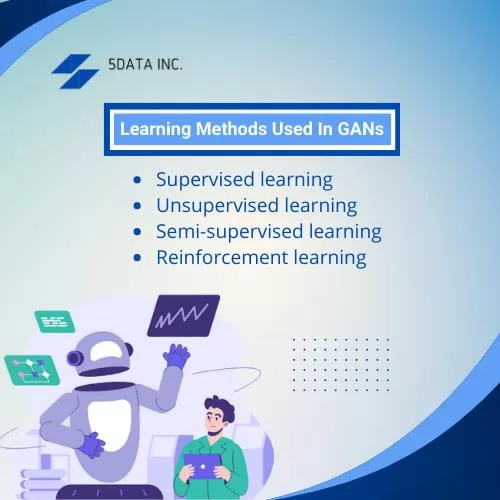What we cover in this blog
The Learning Method Used In GANs
A subsect of machine learning is deep learning, in which every algorithm is placed in an increasingly abstract hierarchy of data augmentation in several processing layers. The process continues until statistical and predictive modeling output with a certain degree of accuracy is generated. The number of processing layers is responsible for imparting the term ‘deep learning,’ it is beneficial to simplify the collation, analysis, and interpretation of huge chunks of complex data. Machine learning has four types of approaches, as follows.Supervised learning:
The data used here is called training data. It is labeled with inputs and the desired outputs and is represented as a matrix. Spam detection, medical diagnosis, and speech recognition are some fields in which supervised learning finds applicability.Unsupervised learning:
It does not require human intervention to make predictions using unclassified and unlabeled data sets. Unsupervised learning tasks include either of the two techniques: cluster analysis and association, both of which are used by businesses in detecting fraud, identifying market segments, and recommending products and services.Semi-supervised learning:
A finding that unlabeled data, when coupled with labeled data, can produce a lot of learning accuracy gave rise to semi-supervised learning that combines both data forms. Its applications include medical image analysis, natural language processing, text classification, and financial fraud detection.Reinforcement learning:
This area uses dynamic programming techniques to focus on the actions to be taken by software agents. Reinforcement training finds applicability in autonomous vehicles, developing patient treatment plans, and playing games against a human opponent. GANs use an unsupervised learning method. They use unlabeled data to train complex data instead of labeled data that requires a lot of manual effort to acquire. GANs are an approach to generative modeling that uses deep learning methods like convolutional neural networks. Such GAN is called a deep convolutional GAN.
Functionality Of Generative Adversarial Network
A generative model of Artificial Intelligence (AI) technology produces content in numerous forms, including audio files, visual images, and text. The concept had its roots in the 1960s when chatbots were introduced.
A notable machine learning model and a prominent AI framework that evolved in 2010 is the Generative Adversarial Network (GAN), which has two neural networks that work together by competing in their accuracy levels. GANs were first introduced by Ian Goodfellow and his fellow researchers at the University of Montreal in 2014.
As the name indicates, the first network in GAN called the generator model, works to generate plausible data to mislead the second one, called the discriminator model. The generator takes in a random input of real data instances to create a training dataset that is indistinguishable from the real one. The second one called the discriminator network, helps in identifying fake data. The fake (generated) data that the generator produces is not part of the domain, and these instances form negative training examples for the discriminator.
GANs are used to generate realistic images, videos, and other content. With the recent development in GANs, the generated images are initially born from random noise. They are later developed into being so realistic, based on a probabilistic model, that it is difficult to figure out the difference between real and fake images. Therefore, the training process involves class labels fed to the discriminator as input to enable it to distinguish the real image files and other content. GAN architecture automatically trains generative models by considering the unsupervised problem as supervised. Problems like image-to-image translation can get a solution using a generative algorithm of GANs.
Furthermore, Super Resolution GANs (SRGANs) have emerged, and they use deep neural networks together with an adversarial network and produce higher-resolution images.
The mathematical equation of GAN can be represented as the following objective function:
Applications of GAN
There are different types of GANs, namely, Vanilla GANs, Conditional GANs, Deep convolutional GANs, and Super Resolution GANs, which are popular owing to the following fields of application.
To create images useful in the field of art, media, education, and marketing
- DCGANs help to train images of cartoon characters to create anime characters for entertainment.
- GANs can generate realistic human face images based on real images. Recently, the face of the Indian mythological character Lord Ram has been AI generated based on the description given in the ancient scriptures.
- Textual descriptions of animals and birds can help GANs to generate realistic images. Firms no longer need supermodels to advertise their products with realistic images in place.
To create scientific images for research
Astronomical images are needed for gravitational lensing and dark matter research, which can be successfully performed using GANs. Many Physics experiments can be carried out using GANs.
To create and improve video games
The entertaining and skill-sharpening pastime of playing video games has a long way to go with the development of GANs.
To create audio and video files
Generative audio and video files can be created from the text using GANs for educative and research purposes.
The Best Application Development Services For Your Business
The constant change that all competitive enterprises need to adapt themselves to is the use of modern technology to streamline and simplify their business functions. If you are no exception and wish to unleash the power of data science to improve your business potential, 5DataInc, the best data engineering services expertized in application development, staffing services, and data analytics, has its doors open. Do reach out to them to take your business ahead through digitization.

Priyamvada
Author
